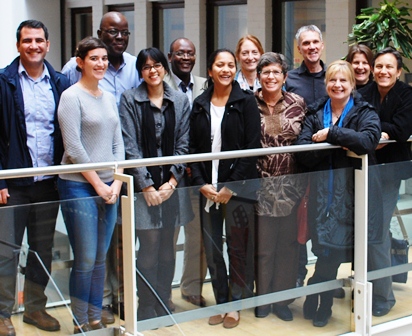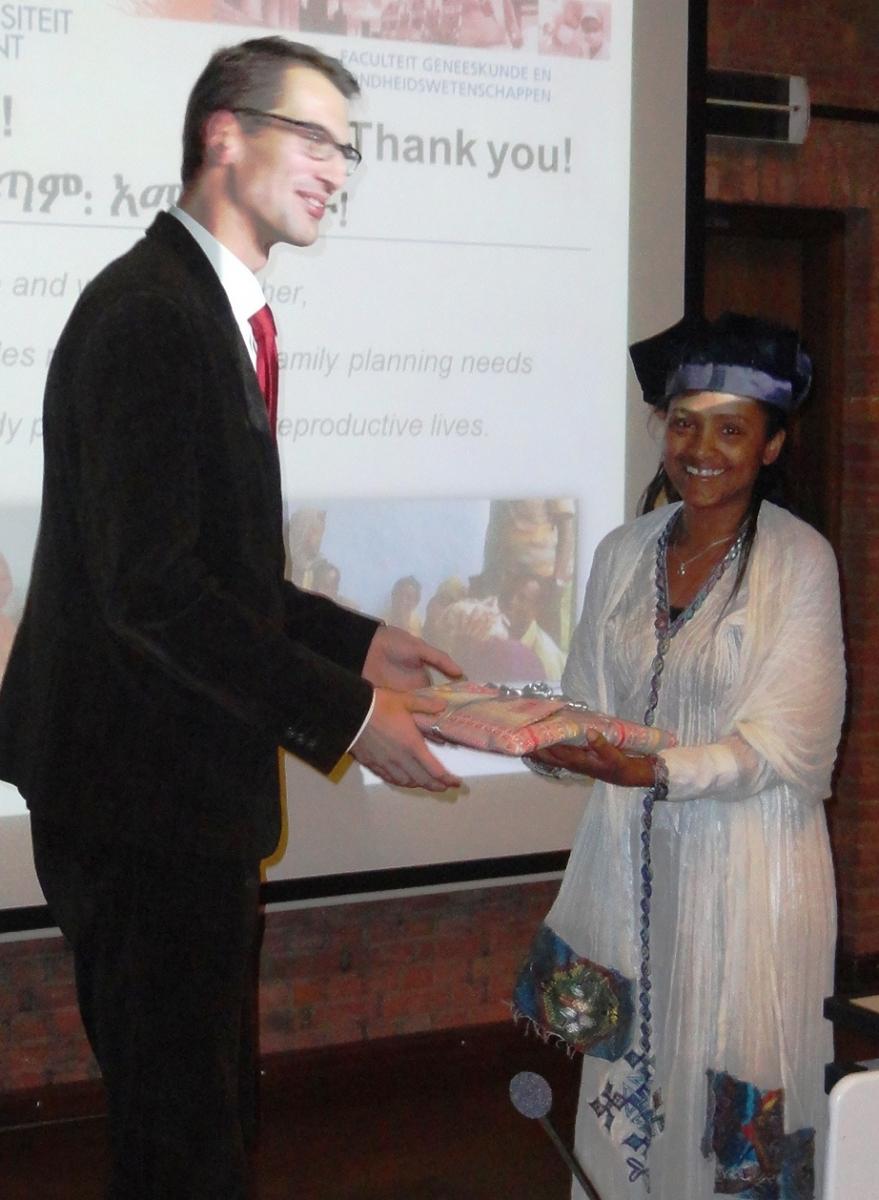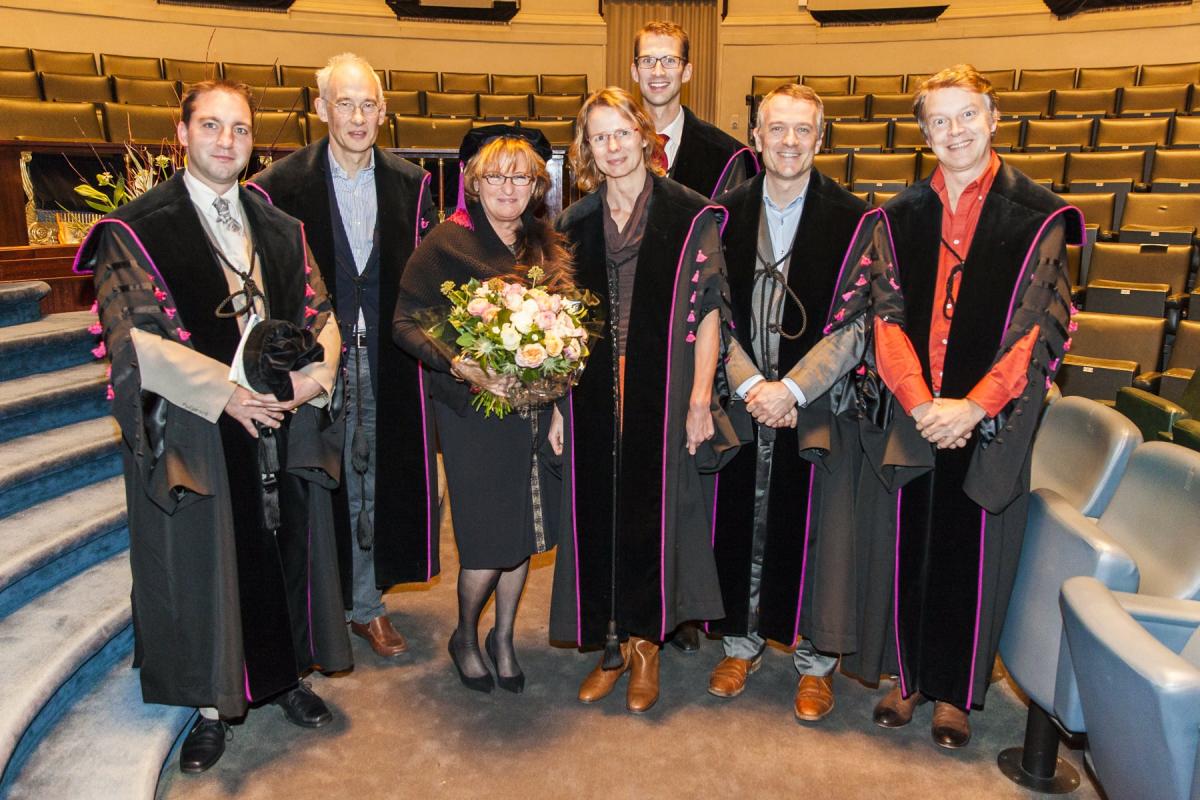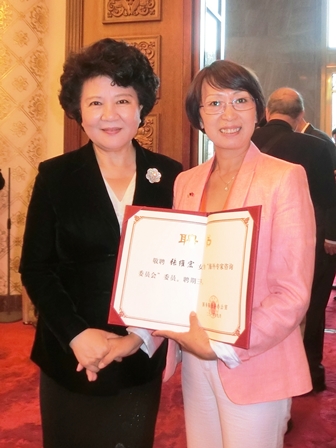Newsletter December 2014
 ICRH Global Newsletter ICRH Global Newsletter 22nd of December, 2014
|
ICRH+20 conference was a great success! ICRH celebrated its 20th anniversary on 4 and 5 December with a well-attended international conference on ‘Sexual and reproductive health and rights today and tomorrow’.
The conference consisted of six symposia: Adolescent sexual and reproductive health and well-being (co-funded by VLIR-UOS); HPV, related diseases and vaccination (in collaboration with Gent University Hospital); Female genital mutilation (In collaboration with the Reference Centre Genital Mutilation of Ghent University Hospital); Forced marriages (In collaboration with RHEA, Centre for Gender and Diversity, Free University Brussels); Maternal health; and behavioural change interventions. This yielded new ideas and insights that will inspire and inform our future work and will undoubtedly also lead to new partnerships. At the end of the conference, a celebration event took place in the presence of the Belgian minister of development cooperation (see picture), the Belgian secretary of state for science policy and numerous colleagues and friends of ICRH. At this event, the new ICRH research strategy for the coming years was presented. Pictures and presentations are available at http://icrhb.org/icrh-conference-2014 |
| PROJECTS |
New project: Estimation of FGM prevalence in the EU On November 15th 2014 the project ‘Towards a better estimation of prevalence of female genital mutilation in the European Union (FGM-PREV)’ has started at ICRH. The project is funded by the DAPHNE program of the European Commission and is conducted in collaboration with the Institut National d’Etudes Démographiques in Paris and The Department of Sociology of the Università degli Studi di Milano-Bicocca in Italy. The general aim is to develop a common definition on FGM prevalence, a common methodology and minimum standards for prevalence estimates of FGM in the EU, in order to generate comparable data. The project includes a pilot study in France and Italy. As a result it will be possible to support a number of initiatives developed to fight and prevent this specific form of violence. Moreover, it will guide policy making, contribute to better target resources, plan interventions, substantiate claims for funds, monitor progress and assess trends. Target groups include civil society organizations, health care providers, child protection, police, school teachers and policy makers. The project will run for two years until November 2016. More information: Els Leye, els.leye@ugent.be |
The MOMI Consortium meeting The MOMI Consortium gathered in Lilongwe, Malawi, for its fourth Project Management Team (PMT) meeting, on 24-26 September.
|
MOMI field visit Els Duysburgh and Aurore Guieu (ICRH-Belgium) visited Burkina Faso and the IRSS team in charge of MOMI in Burkina Faso (28 October – 5 November).
|
The DIFFER Consortium meeting The DIFFER Consortium met for its fourth Project Management Team (PMT) meeting in London, UK, on October 14-16.
|
| EVENTS |
Launch of special Journal of Adolescent Health Supplement Within the margin of the ICRH+20 conference, ICRH and WHO jointly organized a launch of the supplement entitled ‘Where are we in Adolescent Sexual & Reproductive Health and Rights 20 years from the ICPD’.
Dr. Dr Venkatraman Chandra-Mouli presented key messages on each of the five papers – progress and implications for research and action. Ms Jennifer Blum, Program Officer. Population and Reproductive Health, David and Lucile Packard Foundation then spoke about why she believed the Special Supplement was timely and important, and about the positive feedback she had received from the colleagues and collaborators she has sent the Special Supplement to. |
Network statistics and STIs In December 2014, the inaugural meeting of a so-called "Scientific Research Community” (SRC) in the field of Network Statistics for Sexually Transmitted Infections Epidemiology took place in Hasselt, Belgium. This consortium is funded by the Research Foundation - Flanders (FWO) for a period of five years. The SRC will formalise the joining of forces between groups that are internationally acclaimed primarily for their work in STI and HIV epidemiology, microbiology and public health and groups that have an international track record in developing and applying advanced statistical methodology and computer simulations for network analysis. In doing so, the SRC aims to advance science and strengthen academic capacity in network statistics and STI epidemiology. Besides ICRH, the SRC consists of SACEMA at Stellenbosch University, CenStat at Hasselt University, the HIV/AIDS Centre at the Antwerp Institute of Tropical Medicine, the Theoretical Biology Lab at McMaster University, and the Research Methodology Centre at the Human Sciences Research Council (HSRC). More information: wim.delva@ugent.be |
| ICRH PEOPLE |
Tizta Tilahun Degfie on 7 November, dr Tizta Tilahun successfully defended het PhD thesis on ‘Marital dynamics in family planning: the role of couple interaction in Jimma zone, Southwest Ethiopia’.
Study results suggest the importance of involving men in family planning program and shows that empowering women to speak about family planning with their husband helps to enhance their decision making power regarding contraceptive use within the couple. The thesis can be downloaded at http://icrhb.org/publication/icrh-monographs-phd-thesis-tizta-tilahun-marital-dynamics-family-planning-role-couple. More information: tiztatilahun@yahoo.com. |
Mireille Merckx On 7 November 2014, dr. Mireille Merckx successfully defended her PhD thesis on prevention of human papillomavirus and related disease in underage children.
The findings were promising: there is a considerable decrease in HPV 16-incidence in girls aged under 19. For HPV 18 the decrease is not significant, but this may be due to the low prevalence of the genotype. In young women between 19 and 25 years, HPV prevalence did not change. Vaccination in this group is less frequent. The research indicates the positive impact of preventive vaccination, and concludes among others that the development of new preventive and therapeutic vaccines should be priority. The thesis can be downloaded at https://biblio.ugent.be/publication/5765590. More information: mireillemerckx@gmail.com’ |
Wei-Hong Zhang Wei-Hong Zhang, senior researcher and senior project coordinator at ICRH, has recently been appointed +Scientific Advisor to the Overseas Chinese Affairs Office of the State Council for a period of three years.
|
| PUBLICATIONS |
HPV vaccination |
Bacterial vaginosis A longitudinal study was conducted in Kenya, Rwanda and South-Africa. Women were recruited into pre-defined study groups including adult, non-pregnant, HIV-negative women; pregnant women; adolescent girls; HIV-negative women engaging in vaginal practices; female sex workers; and HIV-positive women. Consenting women were interviewed and underwent a pelvic exam. Samples of vaginal fluid and a blood sample were taken and tested for bacterial vaginosis (BV), HIV and other reproductive tract infections (RTIs). This paper presents the cross-sectional analyses of BV Nugent scores and RTI prevalence and correlates at the screening and the enrolment visit. At the screening visit 38% of women had BV defined as a Nugent score of 7–10, and 64% had more than one RTI (N. gonorrhoea, C. trachomatis, T. vaginalis, syphilis) and/or Candida. At screening the likelihood of BV was lower in women using progestin-only contraception and higher in women with more than one RTI. At enrolment, BV scores were significantly associated with the presence of prostate specific antigen (PSA) in the vaginal fluid and with being a self-acknowledged sex worker. Further, sex workers were more likely to have incident BV by Nugent score at enrolment. The authors conclude that their study confirmed some of the correlates of BV that have been previously reported but that the most salient finding was the association between BV and the presence of PSA in the vaginal fluid which is suggestive of recent unprotected sexual intercourse. |
Antenatal and childbirth care in northern Ghana |
Intimate partner violence and pregnancy The overall percentage of IPV was 14.3% 12 months before pregnancy and 10.6% during pregnancy. Physical partner violence before as well as during pregnancy was reported by 2.5% of the respondents (n = 1894), sexual violence by 0.9%, and psychological abuse by 14.9%. Risk factors identified for IPV were being single or divorced, having a low level of education, and choosing another language than Dutch to fill out the questionnaire. The adjusted analysis showed that physical partner violence and psychological partner abuse were significantly lower during pregnancy compared to the period of 12 months before pregnancy. The difference between both time periods is greater for physical partner violence (65%) compared to psychological partner abuse (30%). The analysis of the frequency data showed a similarly significant evolution for physical partner violence and psychological partner abuse, but not for sexual violence. The IPV prevalence rates in are study are slightly lower than what can be found in other Western studies, but even so IPV is to be considered a prevalent problem before and during pregnancy. The study found evidence, however, that physical partner violence and psychological partner abuse are significantly lower during pregnancy. |
Gender equality and sexuality among adolescents in Bolivia and Ecuador It is widely agreed upon that gender is a key aspect of sexuality however, questions remain on how gender exactly influences adolescents' sexual health. The aim of this research was to study correlations between gender equality attitudes and sexual behaviour, sexual experiences and communication about sex among sexually active and non-sexually active adolescents in 2 Latin American countries. In 2011, a cross-sectional study was carried out among 5,913 adolescents aged 14-18 in 20 secondary schools in Cochabamba (Bolivia) and 6 secondary schools in Cuenca (Ecuador). Models were built using logistic regressions to assess the predictive value of attitudes toward gender equality on adolescents' sexual behaviour, on experiences and on communication. The analysis shows that sexually active adolescents who consider gender equality as important report higher current use of contraceptives within the couple. They are more likely to describe their last sexual intercourse as a positive experience and consider it easier to talk with their partner about sexuality. Non-sexually active adolescents, who consider gender equality to be important, are more likely to think that sexual intercourse is a positive experience. They consider it less necessary to have sexual intercourse to maintain a relationship and find it easier to communicate with their girlfriend or boyfriend than sexually non-active adolescents who consider gender equality to be less important. Comparable results were found for boys and girls. These results suggest that gender equality attitudes have a positive impact on adolescents' sexual and reproductive health (SRH) and wellbeing. Further research is necessary to better understand the relationship between gender attitudes and specific SRH outcomes.
|
Preterm birth Preterm birth?(PTB), defined as a delivery before 37?weeks of gestation, is the leading cause of perinatal morbidity and mortality worldwide. Diagnosis of preterm labour as well as accurate prediction of PTB is notoriously difficult. Preterm birth is initiated by multiple mechanisms including infection or inflammation which is the only pathological process for which a firm causal link with PTB has been established. Intrauterine infection evokes an immune response that involves the release of cytokines and chemokines, prostaglandins and matrix-degrading enzymes. These substances trigger uterine contractions, membrane rupture and cervical ripening. Most intra-uterine infections are chronic and subclinical in nature and consequently hard to diagnose before labour or rupture of the membranes. The best studied site of infection is amniotic fluid, but this requires an invasive procedure. A non-invasive approach seems to be more relevant to clinical practice. However, few studies have investigated the maternal inflammatory response during preterm labour. Therefore, the overall objective of this study was to determine several inflammatory markers in maternal serum from pregnant women in labour?(either term or preterm) vs. non-labouring controls. A nested case control study was conducted in which singleton pregnancies were recruited at Ghent University Hospital and divided into groups according to gestational age and labour status. Multiple proteins were evaluated in maternal serum using enzyme-linked or multiplex bead immunoassays including soluble triggering receptor expressed on myeloid cells-1?(sTREM-1), matrix metalloproteinases?(MMP)-9 and MMP-3, tissue inhibitor of metalloproteinases?(TIMP)-1, TIMP-2, TIMP-3 and TIMP-4 and a panel of 30?cytokines, chemokines and growth factors. Tency , Temmerman M, Vaneechoutte M. Inflammatory response in maternal serum during preterm labour. Facts Views Vis Obgyn. 2014;6(1):19-30. |
Rwandan young people's perceptions on sexuality and relationshipsA study aimed at gaining insight into young Rwandans' perceptions on sex and relationships, which is essential for formulating effective sexual and reproductive health (SRH) promotion interventions. Using a 'mailbox technique', this paper studies the spontaneous thoughts of Rwandan young people on sexuality. Mailboxes were installed in five secondary schools in the Bugesera district and students were invited to write about their ideas, secrets, wishes, desires and fears on sexuality and relationships. Of the 186 letters collected, 154 addressed SRH topics. The letters were analysed in NVivo 9 using a theoretical model on vulnerability. Two stereotypical sexual interactions co-exist: experimental sex, taking place unprepared, driven by desire among young people of the same age, and transactional sex, occurring after negotiation between older men/women and younger girls/boys in exchange for money or goods. Both types expose young people to poor, though different, SRH outcomes. Young people have little capacity to manage their vulnerability in these relationships: they have limited knowledge on SRH topics, lack adult guidance or support and have difficult access to condoms. They apply seemingly contradictory norms and behaviours concerning sexuality. In conclusion, the authors formulate several recommendations for SRH interventions.Michielsen K, Remes P, Rugabo J, Van Rossem R, Temmerman M. Rwandan young people's perceptions on sexuality and relationships: Results from a qualitative study using the 'mailbox technique'. SAHARA J. 2014 Jun 20:51-60. [Epub ahead of print] |
Maternal and child health |
HPV vaccination |
'Women at risk' |
Breastfeeding and morbidity in infants |


 During these two days, some 250 scholars, experts and colleagues gathered to consider the state of the art in some of our main fields of activity, and to discuss the remaining challenges and the ways forward.
During these two days, some 250 scholars, experts and colleagues gathered to consider the state of the art in some of our main fields of activity, and to discuss the remaining challenges and the ways forward. The objectives of the meeting were to discuss the progress in the implementation of the interventions as well as other activities linked with the interventions as such (cost collection, monitoring, etc..). The PMT meeting was also an opportunity to discuss the evaluation to take place at the end of the intervention activities as well as dissemination plans, and consequently the timeline for the remainder of the project. The partners had the opportunity to discuss collectively and during one-on-one sessions to tackle specific issues. For more information on the DIFFER project, please visit
The objectives of the meeting were to discuss the progress in the implementation of the interventions as well as other activities linked with the interventions as such (cost collection, monitoring, etc..). The PMT meeting was also an opportunity to discuss the evaluation to take place at the end of the intervention activities as well as dissemination plans, and consequently the timeline for the remainder of the project. The partners had the opportunity to discuss collectively and during one-on-one sessions to tackle specific issues. For more information on the DIFFER project, please visit  Dr Marleen Temmerman, Director Department of Reproductive Health and Research, WHO, made an introductory presentation in which she spoke about the ICPD, about the place of ASRH in the global agenda, about the limited progress made in ASRH since the ICPD, about the importance of taking stock of the progress we have made before we set our sights ahead, and about WHO’s commitment to working with partners to move the agenda forward in research and action. She then launched the Special Supplement.
Dr Marleen Temmerman, Director Department of Reproductive Health and Research, WHO, made an introductory presentation in which she spoke about the ICPD, about the place of ASRH in the global agenda, about the limited progress made in ASRH since the ICPD, about the importance of taking stock of the progress we have made before we set our sights ahead, and about WHO’s commitment to working with partners to move the agenda forward in research and action. She then launched the Special Supplement. In Ethiopia, contraceptive prevalence is less than 30% and the unmet need for family planning is 25%. This is echoed in the country’s population growth which does not match the country´s development, as illustrated by the poor living condition among women. Tizta Tilahun investigated marital dynamics concerning family planning, and assessed the effect that family planning education has on a couple’s interaction and contraceptive use.
In Ethiopia, contraceptive prevalence is less than 30% and the unmet need for family planning is 25%. This is echoed in the country’s population growth which does not match the country´s development, as illustrated by the poor living condition among women. Tizta Tilahun investigated marital dynamics concerning family planning, and assessed the effect that family planning education has on a couple’s interaction and contraceptive use. HPV infections are worldwide an important cause of morbidity and mortality, also for children and early adolescents. Mireille Merckx’ PhD research aimed to describe the prevalence of HPV infections in underage children and to understand the mechanisms of infection.
HPV infections are worldwide an important cause of morbidity and mortality, also for children and early adolescents. Mireille Merckx’ PhD research aimed to describe the prevalence of HPV infections in underage children and to understand the mechanisms of infection. The Scientific Advisors were selected on the basis of their expertise in the field of competence with the significant accomplishments and well-known internationally, and who are in charge of making suggestions and recommendations to the Chinese government on the polities and the strategies related to their expertise. These selected experts represent all the scientific fields. Wei-Hong Zhang is specialized in women’s reproductive health, and is one of 11 females among 120 experts. These experts, coming from 17 countries, met in Beijing between 27 September and 1 October 2014. They also attended the reception on the occasion of the 65th Anniversaries of the Funding of the People's Republic of China on 30 September in the Great hall of the people in Beijing.
The Scientific Advisors were selected on the basis of their expertise in the field of competence with the significant accomplishments and well-known internationally, and who are in charge of making suggestions and recommendations to the Chinese government on the polities and the strategies related to their expertise. These selected experts represent all the scientific fields. Wei-Hong Zhang is specialized in women’s reproductive health, and is one of 11 females among 120 experts. These experts, coming from 17 countries, met in Beijing between 27 September and 1 October 2014. They also attended the reception on the occasion of the 65th Anniversaries of the Funding of the People's Republic of China on 30 September in the Great hall of the people in Beijing.